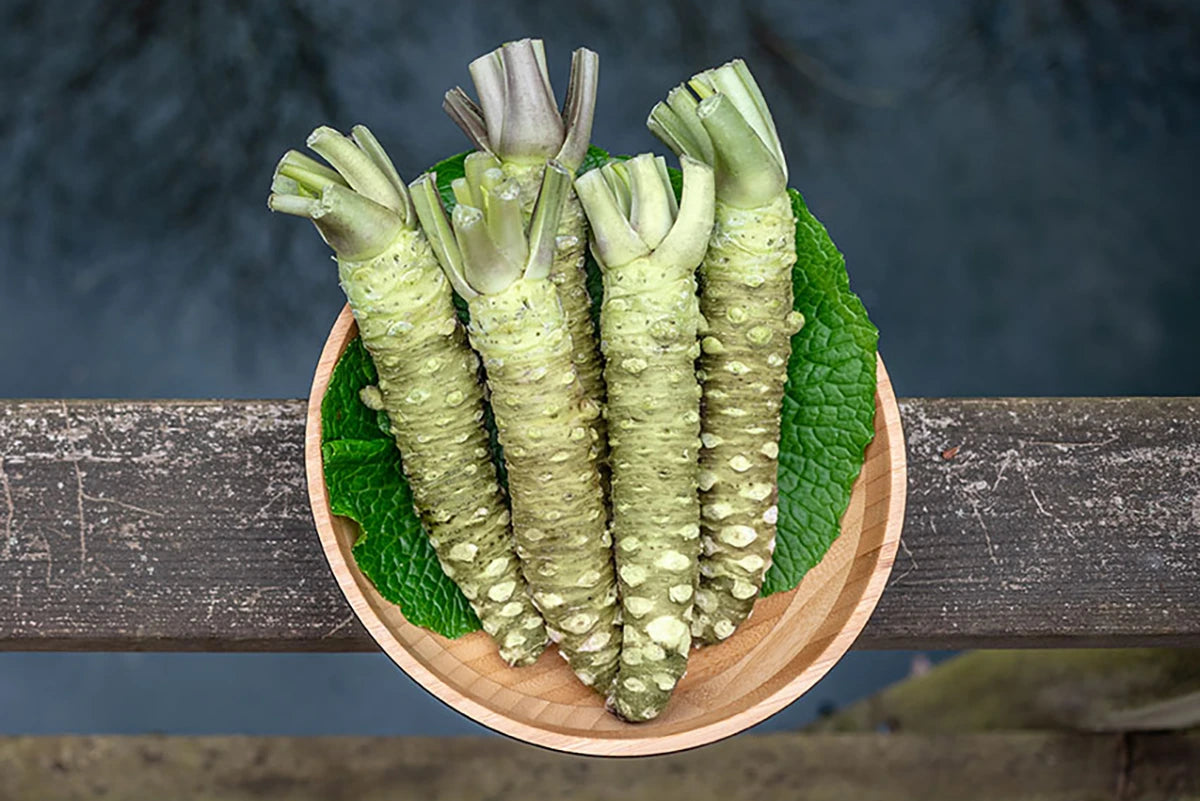
We've all experienced that fiery, nose-tingling sensation that comes with a spoonful of wasabi with our sushi. But have you ever wondered if what you're tasting is the real deal? The truth may surprise you - a vast majority of wasabi served both inside and outside of Japan is not genuine wasabi at all, but an imitation wasabi paste of horseradish, mustard, and green food colouring.
How then can you discern between the authentic and the imitation? This blog post will guide you on an enlightening journey through the captivating world of wasabi, helping you distinguish between the real thing and its sneaky doppelgänger.

What is wasabi?
Wasabi, scientifically known as Wasabia japonica, and colloquially as Japanese horseradish, is a plant native to Japan. The rhizome, when finely grated, yields the spicy, green paste commonly associated with sushi.
Real wasabi has a complex flavour profile - it's not just spicy, but also has subtle, sweet undertones and a unique, fresh aroma that sets it apart from its imitations. It's worth noting that the heat from wasabi does not linger like that of chilli peppers, making it a more palatable option for those who can't handle intense spiciness.
The real deal
So, what makes real wasabi so special? Firstly, it is extremely rare and difficult to cultivate. Wasabi plants require specific conditions - shade, cold temperatures, and constantly flowing water - to grow optimally, which is why they are primarily found in Japan's mountainous regions. Additionally, the harvesting process for wasabi is meticulous and labour-intensive, further adding to its scarcity.
Apart from its rarity, real wasabi also boasts numerous health benefits. It contains high levels of antioxidants, aiding in combating inflammation and promoting overall well-being. Studies have also shown that compounds present in wasabi may help fight certain types of cancer.
The imposters
Now, let's turn our attention to the fake wasabi commonly found in restaurants and supermarkets. This imitation paste is typically made from horseradish, mustard, and green food colouring - a far cry from real wasabi paste. These ingredients are much easier to grow and process than genuine wasabi, making them more cost-effective for commercial use.
While the taste of fake wasabi is similar to that of real wasabi, it lacks the aromatic and flavour complexities that make the latter truly unique. Additionally, horseradish and mustard both have a harsher, longer-lasting heat than genuine wasabi, making them less desirable for those who prefer milder spiciness.

The taste - real vs. fake
Tasting real wasabi is a sensory experience like no other - it has a fresh, herbaceous flavour with a hint of sweetness, followed by a brief, sharp heat that quickly dissipates, leaving a pleasant aftertaste. On the other hand, fake wasabi made from horseradish and mustard has a harsher, more pungent taste that lingers, often overpowering the other flavours in a dish. The absence of the nuanced, aromatic notes found in genuine wasabi is a tell-tale sign you're dealing with an imposter.
The appearance - real vs. fake
The visual difference between real and fake wasabi is subtle, but discernible to the keen observer. Authentic wasabi paste (on the left below), when freshly prepared, has a natural, light green hue, a little bit paler than mint. It has smooth texture due to the finely grated rhizome. On the other hand, counterfeit wasabi often appears brighter, almost neon green due to the added food colouring, it has a gritty texture and almost gel-like consistency. The stark colour difference is one of the easiest ways to distinguish between real and imitation wasabi.

How to eat wasabi
When it comes to consuming wasabi, less is more. Thanks to its potent flavour, a small dab is sufficient to enliven your sushi or sashimi. Sushi connoisseurs often recommend placing the wasabi directly on the sushi piece, between the fish and the rice, to fully appreciate the unique flavour profile of this intriguing condiment. It's advisable to start with a modest amount and adjust according to your heat tolerance.
How to grow your own wasabi
Growing your own wasabi can be a rewarding challenge as this plant has very specific growth requirements. To cultivate wasabi at home, it is best to start by sourcing a high-quality wasabi plant. Plant the wasabi in a pot filled with rich, well-draining soil and place it in a shaded area. Wasabi thrives in a cool, humid environment with temperatures between 45-70°F (7-21°C) and prefers indirect light. The soil should remain moist, but not waterlogged. Regularly check for pests and diseases, as wasabi is susceptible to slugs and fungal infections.
It may take up to two years for the plant to mature and be ready for harvest. If you’re up for the challenge, growing your own wasabi can elevate your culinary experience and bring a touch of authenticity to your Japanese cuisine.

Our wasabi products
Have a read to find the best of our products containing wasabi.
Wasabi powder
Our premium fresh wasabi powder is our own unique blend using English wasabi. To enjoy this powder as fresh wasabi paste, simply add water.
Wasabi plants
Curious about growing your own fresh wasabi? Choose a wasabi plant today from our collection. The entire wasabi plant is 100% edible, making it the best green-fingered gift.
Wasabi oil
This delicious and aromatic wasabi oil is a unique blend of premium quality wasabi and high quality rapeseed oil. It's a versatile ingredient that adds a burst of wasabi flavour to any dish, from sushi and sashimi to grilled meats, carpaccio, mayonnaise, dressings and marinades.
Wasabi vodka
Distilled with the power and flavour of our fresh English wasabi, this small batch vodka captures and releases the complexity of real wasabi. Made with real wasabi and nothing else, the spirit retains a natural creamy smoothness. The powerful, lingering warmth that our wasabi vodka brings has led to it winning a 2020 Great Taste Award!
Wasabi mayonnaise
Fresh-tasting, all-natural mayonnaise perfectly balanced with the mild, authentic flavour of fresh wasabi grown in spring water on our Dorset and Hampshire farms. Wonderfully moreish and versatile, this is the only mayonnaise in the world made with English wasabi. Serve with smoked salmon canapés, spread liberally on your favourite sandwich or liven up a potato salad.

Wasabi mustard
An original, all-natural tangy mustard recipe specifically created to combine beautifully with the authentic flavour of fresh English wasabi. Delicious in ham sandwiches, with beef, patê or cheese. Use in salad dressings and sauces for an original flavour with the unmistakable, aromatic pungency of fresh wasabi.
IMAGE
Fresh wasabi
Our fresh wasabi collection makes the most of the whole wasabi plant.
English & Japanese wasabi
At the Wasabi Company, we have a range of English wasabi grown locally and supplied fresh for the best flavour. Grown in natural, mineral-rich water over at least 18 months, enjoy great quality rhizomes every time.
Imported from the famed Shizuoka prefecture, our Japanese wasabi rhizomes are full of fresh, complex flavour.
Flowers
Wasabi plants offer more than you might think - as well as the pungent rhizomes, you can actually make use of the entire plant. These fresh wasabi flowers can be eaten raw, providing just a little tickle of heat. They make a pretty garnish for maki rolls or fish dishes.
Leaves and stems
Japanese wasabi leaves are large, heart-shaped and have a wasabi flavour with a mild wasabi heat. In Japan, they’re popular fried in tempura batter - but the leaves are also excellent stir fried, sautéed or boiled with noodles and stews. Traditionally pickled in sake lees, stems have an excellent crunch with a radish and spring onion flavour when raw - an unusual accompaniment to sushi or sashimi alongside real wasabi paste. A wasabi stem also makes an excellent stirrer for a wasabi Bloody Mary.
Wasabi Starter Kits & Collections
Fresh Wasabi Starter Kit
This Fresh Wasabi Starter Kit is the perfect introduction to the classic, complex flavour that the fresh wasabi taste offers. Truly an original gift for any foodie, this starter kit includes a specially designed wasabi grater to create a fine paste, and a bamboo brush to gather and mix the freshly grated wasabi - as well as the essential fresh wasabi rhizome, of course.
Fresh Wasabi Starter Kit, Plant & Condiment Set
Containing a fresh wasabi rhizome, a wasabi grater, and a bamboo brush, this kit goes the extra mile with the addition of your own wasabi plant - as well as our award-winning wasabi mustard and mayonnaise!
Fresh Wasabi Pro & Grow Kit
One of our most popular gift packs, this kit includes a generous amount of fresh wasabi, a grating kit and a wasabi plant that can be grown in the garden or in a pot.
Wasabi Freaks Collection
This collection is perfect for serious wasabi fans, looking to experience the adventurous flavour of authentic fresh wasabi. The three award-winning products included - wasabi mustard, mayonnaise and vodka - are a feast for the senses for budding and professional chefs.
Wasabi Mega Freaks Collection
A wasabi plant and detailed grow guide allows you to grow your own wasabi - a unique and original gift for any foodie. Our multi-award winning Wasabi Vodka, Wasabi Mustard and Wasabi Mayonnaise complete the set, all made with 100% natural ingredients and powerfully flavoured by our very own, English grown fresh wasabi.
Buy all your authentic wasabi products from The Wasabi Company
To enjoy the best wasabi taste, shop our authentic wasabi products here. Real wasabi paste can be easy to make for yourself, and you can even grow your own wasabi plant! Make the most delicious Japanese cuisine with fresh wasabi today.

